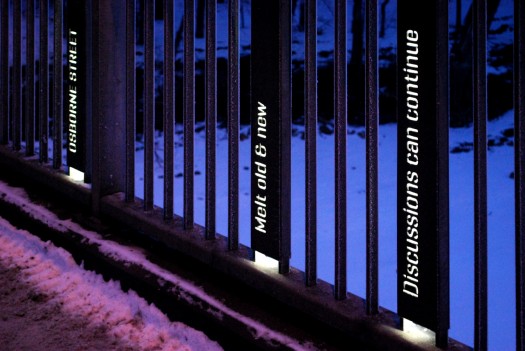A Placemaking Journal
Creative Placemaking:
From here until now

We’ve been talking for the last few weeks about how happiness and health are generated or depleted by the way our neighbourhoods, towns, cities, and rural landscapes are developed – here, here, and here. We’ve been discussing these ideas in national terms, looking at indices and trends. During this study, I couldn’t help but reflect on the elements of place that make me the happiest, personally.
If you’re a frequent reader on PlaceShakers, you probably already know that I’m inspired and delighted by great cycling cities, cycling through nature, gardening, retail streets, travel, living outdoors, cottage living, and art.
“Health (at the level of populations) can be defined as complete physical, mental, and social well-being. … Leading causes of morbidity and mortality are heart disease, cancer, diabetes, stroke, injuries, and mental illness. Many of these are related to community design choices.” ~ Making Healthy Places
For me personally, places that generate the highest levels of mental and social well-being are the outcomes of creative placemaking, a discipline recently getting an injection of capital from ArtPlace. It’s a private-public consortium providing “a means of investing in art and culture at the heart of a portfolio of integrated strategies that can drive vibrancy and diversity so powerful that it transforms communities.” (If you’re part of the crowd tempted to feel snarky about these concepts, Ben Brown has an inoculation for you here.)
Some creative placemaking has to do with local farming, artisanal food production, field-to-fork dining, and local art making, such as the Los Poblanos Historic Inn and Organic Farm, which I look forward to visiting next month. The authenticity, siting, ancient history, and serenity of this place make you feel like you just visited your chi master, yogini, or psychotherapist. And the results allow the farm, inn, restaurant , and shop to employ 100 people on 25 acres, delivering degrees of economic resilience rarely achieved without creativity.
Other outcomes of creative placemaking are largely anchored by public art. My favourite experience in that realm this month was the opening of From Here Until Now, designed by spmb artists and architects, Karen Shanski and Eduardo Aquino, in collaboration with the Winnipeg Arts Council Public Art Program, the City of Winnipeg, the Osborne Bridge design team, and the public at large.
It’s a bridge. Discrete and minimal. But it’s also a public artwork that ties in the local urbanism and culture in a serene and delightful way.
Many of the statements within the poetry portion of the artwork resonate with the urbanist in me, “Strong sense of place” … “Pedestrian oriented scale” … “A gathering place” … others with the poet, “Demolished and altered” … “Thinking alone together” … “The Prairie Meadowlark” …
“The work intends to give a sense of place to the bridge without overtly altering the public space. The idea was for the experience to gradually grow on the passer-by over a long time. The project creates a narrative about the culture, the history, and the poetry of the communities both south and north of the bridge. As the viewer passes through the site, it becomes revealed that she is in fact walking/riding on top of the neighborhood’s map, and she will glimpse on one of the 100 pickets small snippets of the neighborhood’s identity through short phrases. Some of the phrases may not be clear at first as they are composed in poetic, fragmented language to provoke curiosity and conversation among people.” ~ Eduardo Aquino
On this busy street leading out of downtown, I find that the bridge both draws me outside as well as entertains me while in the calmed traffic along Osborne Street. In this multi-modal environment, people daily walk, cycle, drive, and bus across the bridge, or take a boat or watertaxi underneath in it the summer, or in winter skate, walk, run or sled along the longest naturally frozen skating trail in the world. My primary complaint about the roadway renovation is that the bike lanes end on the south end of the bridge, making it a route I avoid while cycling during rush hours.
While not loud or glamorous, From Here Until Now adds subtle placemaking to the seam between the already character-rich neighbourhoods of Osborne Village and downtown, two blocks away from the Winnipeg Art Gallery, Canada’s oldest civic art museum.
“When I first encountered From Here Until Now it made me slow down and examine the parts. And that’s one of the most powerful elements of public art — it has the ability to take us away for a moment of exploration or reflection. I read the work by Aquino and Shanski less as an individual piece and more as an accompaniment on my walk across the Osborne Street Bridge. Bridges are for people, not just cars.” ~Stephen Borys
One of the pickets in the bridge reads, “Affluence creates poverty,” a quote from the great Canadian philosopher of communication theory, and former area resident, Marshall McLuhan. While we have a long way to go to mitigate the gentrification inherent in creative placemaking outcomes, it’s worth figuring given the other significant value-driving benefits to health, environment, and economy. Not to mention the simple satisfaction of the experience.
Check out the entire Urban Happiness Series here.
–Hazel Borys
If PlaceShakers is our soapbox, our Facebook page is where we step down, grab a drink and enjoy a little conversation. Looking for a heads-up on the latest community-building news and perspective from around the web? Click through and “Like” us and we’ll keep you in the loop.












